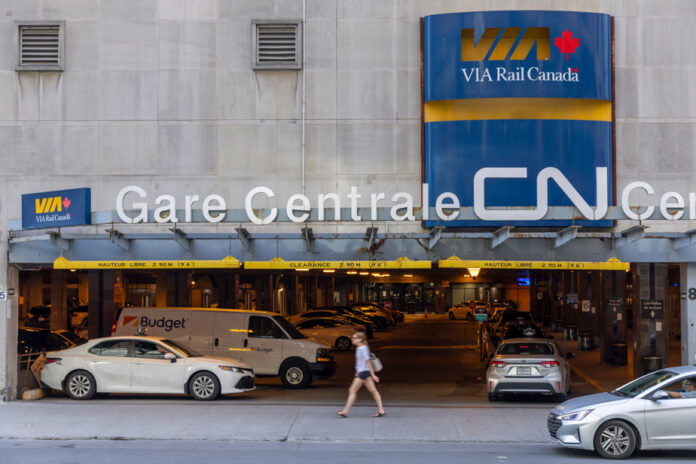A high-speed train (TGV) between Quebec and Toronto would cost up to 80 billion, says Transport Canada, citing an update of a study carried out three years ago. The average cost per kilometer is said to be higher compared to several ongoing projects elsewhere in the world, which surprises an expert.
Ottawa favors the option of a high frequency train (HFR) between Quebec and Toronto.
A TGV would cost up to 80 billion, according to recent estimates from Transport Canada.
Cost estimates for a TGF remain unknown.
If questions about the bill for a high-frequency train (TGF) – the option favored by the Trudeau government – remain unanswered, Ottawa is less embarrassed to advance on that of the option which it considers too expensive. . The price of such a project would vary between 65 and 80 billion, says Transport Canada, in an email sent to La Presse.
This conclusion is reached following an update of a study on the TGV, whose trains can reach 300 km / h, carried out in 2020 as part of research carried out for the TGF, explains a spokesperson. from Transport Canada, Hicham Ayoun.
“The study used international benchmarks to establish the overall costs of HSR in the corridor,” he writes. Several networks in service around the world were examined, including those of England, Spain, France, Japan, South Korea and Germany. »
At the time of writing these lines, it had not been possible to consult the contents of the study in question. If trains were to run at high speed “end to end” between Quebec City and Toronto, the cost of the project would be $65-80 million per kilometer.
With dedicated passenger rail tracks and trains that can reach speeds of 200 km/h, the TGF must connect cities such as Quebec, Montreal and Toronto with a travel time that would not exceed 4 hours and 10 minutes. However, the Trudeau government is asking the selected consortia to propose scenarios where high speed could be deployed. This would reduce travel times.
Several actors in the business community and the political sphere, including the Legault government, openly plead for a high-speed network, which would allow, for example, to make the connection between the metropolis and the Queen City in about 2 hours and 15 minutes. . Ottawa repeats that the bill would be too high because many viaducts and tunnels would have to be built to avoid level crossings.
“TGVs are usually designed to optimize travel between two major cities, with limited stops in between,” adds Ayoun. The TGF would be able to serve small communities between major cities and reach busy downtown stations. »
The Trudeau government is much more discreet when it comes to high-frequency train costs. Federal Transport Minister Omar Alghabra – who will be dismissed from the Cabinet on Wednesday – had already mentioned a scale ranging from 6 to 12 billion for the TGF. He retracted in March 2022 and has since refused to make any predictions.
Specialist in urban issues, Michel Archambault, professor emeritus in the department of urban and tourism studies at UQAM, is surprised by the range of the average cost per kilometer put forward by Transport Canada for a TGV. In his opinion, this is higher than what is observed elsewhere in the world. Mr. Archambault cites for example the 35 million euros per kilometer (about 51 million CAN) for the extension of the TGV network in France to link Bordeaux and Toulouse.
“That’s well below the costs quoted by the federal government,” says Archambault. The section between Quebec and Toronto is one of the most favorable in terms of the absence of structuring obstacles that would significantly increase the bill. »
The expert also points out that in Tunisia, the Statista agency had estimated the cost per kilometer of the 600 km railway project for high-speed trains in this country at around 20 million euros (some 30 million CAN). country.
Elsewhere, the picture is quite different. In the case of the HS2 project between London and Birmingham in the north, the average cost per kilometer was estimated at over £200 million (CAN340 million). It is the most expensive TGV project on the Old Continent and the explosion of costs is prompting the British government to consider taking measures, such as reducing the number of trains and top speeds, in order to deflate costs.
In California, the network planned to connect Los Angeles to San Francisco – a project that must be broken down into several phases – could cost up to 128 billion US (168 billion CAN). The price per kilometer is over 125 million US (165 million CAN).
“When you look at this network, it is very different from the corridor between Quebec and Toronto, underlines however Mr. Archambault. You have to go through mountains, in particular, and there are a lot of obstacles. To this must be added everything related to seismic activity, since it is on the American west coast. »
Without advancing on the costs, a government document prepared in 2021 and obtained by La Presse had already identified the section between Montreal and Toronto as one of the most promising for the TGV in North America. The information came from a report of about 300 pages by the Joint Project Office (JPO), under the responsibility of VIA Rail and the Canada Infrastructure Bank.
The findings were based on an assessment by the Regional Plan Association. This New York-based nonprofit had rated 31 rides. The one between the two Canadian cities ranked sixth on the continent. This report is heavily redacted. Impossible, therefore, to know if he was advancing on the invoice and the technical constraints of a TGV.
Scotiabank’s stock market value, fourth largest in Canada (78 billion)
Almost twice the total value of NHL teams – C$43 billion – calculated by Forbes.
At least ten times the alleged bill (7 billion) of the Metropolitan Express Network (REM).















